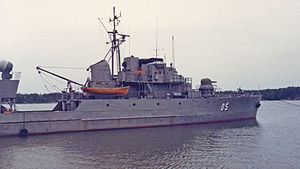
Finnish minelayer Keihässalmi
Encyclopedia

Pennant number
In the modern Royal Navy, and other navies of Europe and the Commonwealth, ships are identified by pennant numbers...
"05") was a minelayer
Minelayer
Minelaying is the act of deploying explosive mines. Historically this has been carried out by ships, submarines and aircraft. Additionally, since World War I the term minelayer refers specifically to a naval ship used for deploying naval mines...
of the Finnish Navy
Finnish Navy
The Finnish Navy is one of the branches of the Finnish Defence Forces. The Navy employs 2,300 people and about 4,300 conscripts are trained each year. Finnish Navy vessels are given the ship prefix "FNS" simply short for "Finnish Navy Ship"...
. She was commissioned in 1957 and remained in service until 1994, after which she was turned into a museum ship in Turku
Turku
Turku is a city situated on the southwest coast of Finland at the mouth of the Aura River. It is located in the region of Finland Proper. It is believed that Turku came into existence during the end of the 13th century which makes it the oldest city in Finland...
. The vessel was named after the strait of Keihässalmi, which is located in Sipoo
Sipoo
Sipoo is a municipality of Finland. Its seat is in Nikkilä/Nickby.It is the eastern neighbour of Helsinki and is located in the Uusimaa region. The municipality has a population of and covers an area of ofwhich is water...
. Keihässalmi was the first Finnish minelayer to be constructed after World War II
World War II
World War II, or the Second World War , was a global conflict lasting from 1939 to 1945, involving most of the world's nations—including all of the great powers—eventually forming two opposing military alliances: the Allies and the Axis...
.
Keihässalmi was designed according to lessons learned from the Ruotsinsalmi class minelayers
Ruotsinsalmi class minelayer
The Ruotsinsalmi class minelayers were a two-strong class of minelayers in the Finnish Navy.Both ships were launched in 1940 and named after famous 18th century sea battles between Sweden and Russia.- New minelayers for the navy :...
, but with increased size and tonnage. It was stronger, more seaworthy and faster than its predecessor. The construction took place from 1956 to 1957 at the Valmet Oy shipyard in Helsinki. The sinking of the minelayer Riilahti
Finnish minelayer Riilahti
Riilahti was a Ruotsinsalmi class minelayer of the Finnish Navy. Riilahti was commissioned in 1940 and sunk in 1943. The vessel was named after the battle of Riilahti, which was fought between Sweden and Russia in 1714.- New minelayers for the navy :...
in 1943 had left a big gap in Finnish mine warfare capabilities, and a new vessel was needed. It would last until the mid-1950s before this was addressed, due to the harsh after-war conditions and war-payments which included a large number of ships to be constructed at Finnish shipyards.
The Keihässalmi was fitted with almost all weapons systems available to the Finnish Navy (except torpedoes), although she primarily was a minelayer
Minelayer
Minelaying is the act of deploying explosive mines. Historically this has been carried out by ships, submarines and aircraft. Additionally, since World War I the term minelayer refers specifically to a naval ship used for deploying naval mines...
and minesweeper
Minesweeper (ship)
A minesweeper is a small naval warship designed to counter the threat posed by naval mines. Minesweepers generally detect then neutralize mines in advance of other naval operations.-History:...
. Keihässalmi was launched on 16 March 1957 and the vessel remained the largest vessel of the Finnish Navy until 1962, when the frigate Matti Kurki was purchased. It was also used as a sort of test-bed for multiple systems. At one point a 75 mm gun was fitted to the ship, as the Finnish Navy lacked designated gunships. The ship was also used for training, and was sent out on trips every sailing season. The Keihässalmi was cheap to operate and required a low complement (important as the Finnish Navy had a manpower restriction), but the vessel proved itself over the decades. The ship underwent repairs and refitting from 1975 until 1981, when its seaworthiness was improved by the installment of ballast tank
Ballast tank
A ballast tank is a compartment within a boat, ship or other floating structure that holds water.-History:The basic concept behind the ballast tank can be seen in many forms of aquatic life, such as the blowfish or argonaut octopus, and the concept has been invented and reinvented many times by...
s. The forward mine section was slightly modified to allow the vessel travel in high seas. The weaponry was modernized and the gunlaying was now radar-guided. Keihässalmi was the flagship of the Finnish Navy and she made many visits to other countries in the 1960s. She was the official school ship of the navy from 1975 until 1979, awaiting the replacement for the Matti Kurki. Keihässalmi was retired and turned into a museum ship in 1994. She is currently on display at the Forum Marinum museum in Turku
Turku
Turku is a city situated on the southwest coast of Finland at the mouth of the Aura River. It is located in the region of Finland Proper. It is believed that Turku came into existence during the end of the 13th century which makes it the oldest city in Finland...
.

